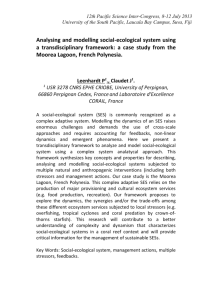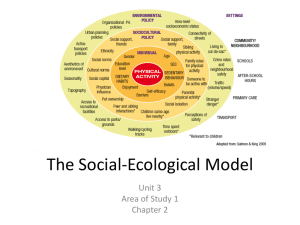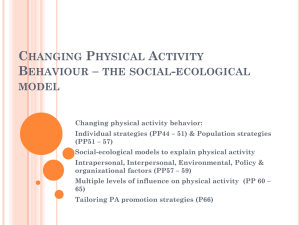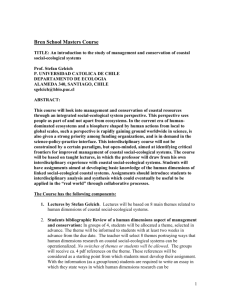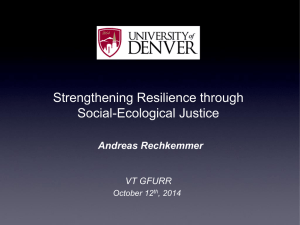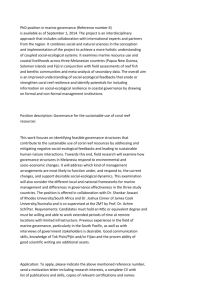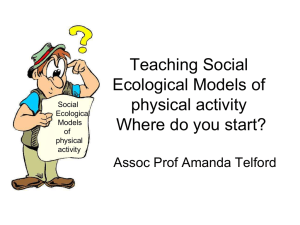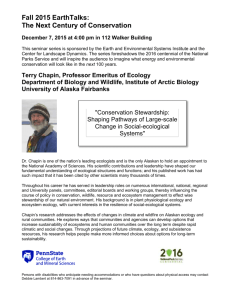Social Ecological model and physical activity
advertisement
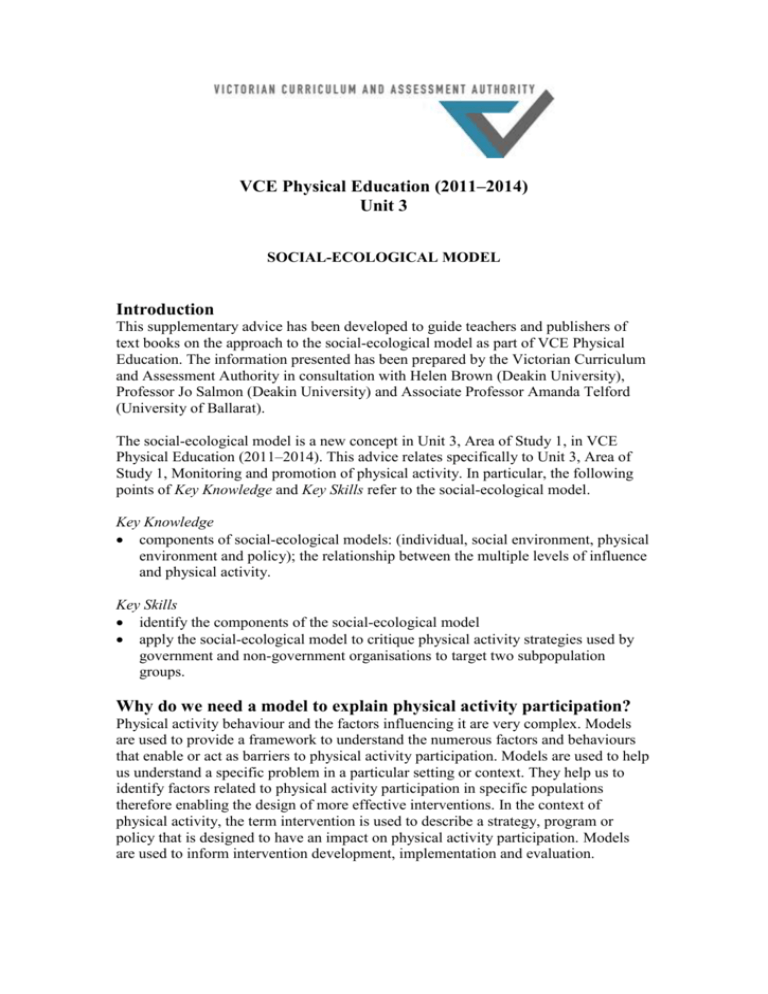
VCE Physical Education (2011–2014) Unit 3 SOCIAL-ECOLOGICAL MODEL Introduction This supplementary advice has been developed to guide teachers and publishers of text books on the approach to the social-ecological model as part of VCE Physical Education. The information presented has been prepared by the Victorian Curriculum and Assessment Authority in consultation with Helen Brown (Deakin University), Professor Jo Salmon (Deakin University) and Associate Professor Amanda Telford (University of Ballarat). The social-ecological model is a new concept in Unit 3, Area of Study 1, in VCE Physical Education (2011–2014). This advice relates specifically to Unit 3, Area of Study 1, Monitoring and promotion of physical activity. In particular, the following points of Key Knowledge and Key Skills refer to the social-ecological model. Key Knowledge components of social-ecological models: (individual, social environment, physical environment and policy); the relationship between the multiple levels of influence and physical activity. Key Skills identify the components of the social-ecological model apply the social-ecological model to critique physical activity strategies used by government and non-government organisations to target two subpopulation groups. Why do we need a model to explain physical activity participation? Physical activity behaviour and the factors influencing it are very complex. Models are used to provide a framework to understand the numerous factors and behaviours that enable or act as barriers to physical activity participation. Models are used to help us understand a specific problem in a particular setting or context. They help us to identify factors related to physical activity participation in specific populations therefore enabling the design of more effective interventions. In the context of physical activity, the term intervention is used to describe a strategy, program or policy that is designed to have an impact on physical activity participation. Models are used to inform intervention development, implementation and evaluation. VCE PHYSICAL EDUCATION 2011-2014 Social-ecological model Why use the social-ecological model? Research suggests that the social, physical and policy environments impact on the ability or likelihood of individuals participating in physical activity. Human behaviour is difficult to change, especially in an environment that does not support change. In order to increase physical activity, efforts need to focus not only on the behaviour choices of each individual but also on factors that influence those choices. The socialecological model helps to identify opportunities to promote participation in physical activity by recognising the multiple factors that influence an individual’s behaviour. Efforts to change behaviour are more likely to be successful when the multiple levels of influence are addressed at the same time. The previous study design referred to the ‘Stages of Change’ and ‘Self-efficacy’ as theoretical models to explain participation in physical activity. Both of these models focus on the individual and the psychology of the change process. While these models continue to be useful, they do not take into consideration the multiple factors which influence physical activity participation such as the social environment, the physical environment and public policy. The VCE Physical Education Study Design (2011– 2014) is taking into consideration the multiple levels of influence on physical activity participation by identifying the social-ecological model to critique strategies designed to promote physical activity participation. Background to social-ecological model The term ecology originates in the biological sciences and refers to the interrelationships between organisms and their environments. Ecological and socialecological models of human behaviour have evolved over a number of decades in the fields of sociology, psychology, education and health and focus on the nature of people’s interactions with their environments. Health behaviours, including physical activity participation, are thought to be improved when environments and policies support healthy choices, and individuals are motivated and educated to make those choices (World Health Organisation 1986). Educating people to make healthy choices when environments are not supportive will not be effective in making behavioural change. The social-ecological model acknowledges that it takes a combination of both individual level and environmental/policy level interventions to achieve substantial changes in health behaviours, including physical activity behaviour. The social-ecological model developed out of the work of a number of prominent researchers. These include: Urie Bronfenbrenner’s Ecological Systems Theory (1979), which focused on the relationship between the individual and the environment. Kenneth McLeroy’s Ecological Model of Health Behaviours (1988), which classified five different levels of influence on health behaviour, although this did not include physical environment, which is an essential element of a socialecological model of physical activity. Daniel Stokols’s Social Ecology Model of Health Promotion (1992, 2003), identified the core assumptions which underpin the social-ecological model (Glanz 2008, pp. 468–469). © VCAA, April 2010 2 VCE PHYSICAL EDUCATION 2011-2014 Social-ecological model The work of these and other researchers has been used and modified and has evolved into what is referred to as the social-ecological model. Components of the social-ecological model There are a number of versions of the social-ecological model, which use slightly different classifications of environmental influences. For the purposes of VCE Physical Education the social-ecological model made up of the individual, social environment, physical environment and policy components. Bronfenbrenner’s work saw the influences on behaviour as a series of layers, where each layer had a resulting impact on the next level. He described these layers as being like being a series of Russian dolls, where the innermost level represents the individual, which is then surrounded by differing levels of environmental influences (Bronfenbrenner 1994). For example, an individual’s social environment of family, friends and workplace are embedded within the physical environment of geography and community facilities, which is in turn embedded within the policy environment of different levels of government or governing bodies. All levels of the social-ecological model impact on the behaviour of the individual (Stokols 1996, p. 291). The socialecological model represents this concept as a series of overlapping circles, with each circle representing a different layer or component of the model. The social-ecological model needs to be tailored to suit particular behaviours and population groups. For example, adolescents will perform different physical activities in different settings to older adults; therefore intervention strategies would differ for each population. While the components of the social-ecological model will remain the same and can be used in a range of populations, the specific examples within each component will vary depending on the population group (Elder 2007, p. 156). © VCAA, April 2010 3 VCE PHYSICAL EDUCATION 2011-2014 Social-ecological model Individual The individual is at the centre of the social-ecological model. This level includes personal factors that increase or decrease the likelihood of an individual being physically active. Individual factors which influence physical activity participation include: knowledge, attitudes, behaviours, beliefs, perceived barriers, motivation, enjoyment skills (including fundamental motor skills and sports specific skills), abilities, disabilities or injuries age sex level of education socioeconomic status employment status self-efficacy. Strategies which bring change at the individual level tend to focus on changing an individual’s knowledge, attitudes, behaviour and skills. They include education and mentoring programs. Social environment Surrounding the individual in the social-ecological model is the social environment. The social environment comprises the relationships, the culture and the society with whom the individual interacts. The social environment has a significant influence on physical activity behaviour. For example, having someone such as a peer, family member or work colleague to be physically active with can impact on physical activity behaviour. The social environment includes: family, such as the influence of parental and sibling physical activity levels and family support spouse or partner peers institutions and organisations, such as schools, workplaces and community organisations access to social support networks versus social isolation influence of health and other professionals such as doctors, teachers and coaches community norms cultural background socioeconomic status of the community Strategies which bring change at the social environment level include community education, support groups, peer programs, workplace incentives and social marketing campaigns. These are used to promote positive community attitudes and awareness to participation in physical activity. © VCAA, April 2010 4 VCE PHYSICAL EDUCATION 2011-2014 Social-ecological model Physical environment Physical activities take place in physical environments. Physical environment includes the natural environment and the built (or man-made) environment. Physical environments are likely to influence the amount and type of physical activity, this influence can be positive or negative. For example, physical environments such as sports fields, bike paths, swimming pools and gymnasiums are designed for physical activity, while other physical environments such as workplaces, schools, family homes or theatres may discourage, restrict or prohibit physical activity. The physical environment includes: natural factors such as weather or geography availability and access to facilities such as parks, playgrounds, sporting grounds, gymnasiums, walking or cycling tracks aesthetics or perceived qualities of facilities or the natural environment safety such as crime rates or amount and speed of traffic community design such as connectivity of streets, living in a cul-de-sac, density of housing or land use public transport. The built environment provides opportunities for intervention, such as the inclusion of walking or bicycle tracks and parks in new housing developments and ease of access to them. The natural environment has fewer opportunities for intervention; these tend to focus on overcoming barriers to physical activity within the natural environment. Strategies focusing on the physical environment usually should be put in place before educational or community awareness initiatives are attempted. Sometimes educational initiatives encourage impossible or unrealistic behaviour. For example, media campaigns that encourage people to walk will be ineffective in communities where there are no or poorly maintained walking paths or where safety is an issue. In this scenario, education and awareness programs are more likely to be effective when preceded by programs for the development of community facilities and promoting community safety (Sallis 1998, p. 381). Policy This refers to legislation, regulatory or policy making actions that have the potential to affect physical activity. These are often formal legal actions taken by local, state or federal governments but also can be informal local policies or rules in settings such as schools or workplaces. Policy includes: urban planning policies active transport policies education policies such as mandating time for physical education classes health policies environmental policies workplace policies funding policies. Developing the political will to implement policies promoting physical activity participation can sometimes be difficult. Strategies which align physical activity participation with priorities from other sectors can increase the chances of succeeding. For example, climate change is a significant issue and the context of reducing reliance © VCAA, April 2010 5 VCE PHYSICAL EDUCATION 2011-2014 Social-ecological model on fossil fuels and the reduction of greenhouse gas emissions provides the opportunity to combine both health and environmental policies to promote physical activity participation (Katzmarzyk 2008, p. 381). Core principles The social-ecological model is based on four core principles: 1. Multiple factors influence behaviours. Therefore efforts to change behaviour, including physical activity behaviour, should be based on the understanding of the interrelationship between the four levels of the social-ecological model: individual, social environment, physical environment and policy. Physical activity interventions are more likely to be successful when they target multiple components of the social-ecological model. 2. Environments are multidimensional and complex. Social or physical environments can be described as containing a variety of features or attributes, such as the size, temperature, facilities and safety. Environments can also be described in terms of their actual or perceived qualities. The variable nature of environments has a direct implication on the design of initiatives to promote physical activity participation. For example, a community may have good access to parks which are easily accessible and well equipped with play equipment for children, however parental perceptions about traffic safety en-route to the park and ‘stranger danger’ may prevent children from using this aspect of their physical environment. 3. Human-environment interactions can be described at varying levels of organisation. Human interactions with the environment can occur at individual, small group, organisational, community or population levels. The socialecological model does not just focus on the individual but includes multiple levels of human interaction with environments. For example, interventions promoting physical activity can be large such as whole population mass media campaigns or may focus on organisations such as a school or workplace settings or may be based around a local community which they are tailored to. The effectiveness of campaigns to promote physical activity is enhanced when they target differing levels of the human-environment interaction. 4. The interrelationships between people and their environment are dynamic. There is a reciprocal relationship between people and their environments. The social, physical and policy environments influence the behaviour of the individual, while at the same time behaviour of the individual, group or organisation also impact on the wellbeing of their environments. The environment can control or set limits to the physical activity behaviour that occurs within it. Making a change in the environment can result in a modification of behaviour (Stokols 1992, p. 7 and Jamner & Stokols 2000, pp. 27–28). Example of this reciprocal relationships include: lack of access of facilities such as a swimming pool limits the number of people who are able to undertake swimming as an activity (environment influencing behaviour) increasing numbers of people riding bicycles and lobbying of community groups has influenced governments to include facilities such as bike paths and bicycle lanes on roads (behaviour influencing the environment). © VCAA, April 2010 6 VCE PHYSICAL EDUCATION 2011-2014 Social-ecological model Conclusion The social-ecological model represents a comprehensive approach to designing, implementing and evaluating interventions which target the multiple influences on behaviour including physical activity behaviour. This model has evolved over a number of years and has been influenced by various researchers; therefore, some references will use slightly different classifications of the components of this model. For the purposes of VCE Physical Education (2011–2014), the study design identifies the following components of the social-ecological model: individual social environment physical environment policy. Students will be required to understand and identify specific examples of the components of the social-ecological model. They will also be required to apply the social-ecological model to critique strategies used by both government and nongovernment organisations to promote physical activity to target sub-population groups. References Bronfenbrenner, U 1994 ‘Ecological Models of Human Development’, International Encyclopaedia of Education, Vol 3, Oxford, Elsevier. Elder, J P, Lytle, L, Sallis, J F, Young, D R, Steckler, A, Simons-Morton, D, Stone, E, Jobe, J E, Stevens, J, Lohman, T, Webber, L, Pate, R, Saksvig, B I and Ribisl K 2007, ‘A Description of the Social-Ecological Framework used in the Trial of Activity for Adolescent Girls’, Health Education Research, vol. 22, no. 2, pp. 155–165. Glanz, K, Rimer B K & Viswanath, K (eds) 2008, Health Behaviour and Health Education – Theory, Research and Practice, 4th edn, John Wiley and Sons, San Francisco, USA. Green, L W, Richard, L & Potvin, L 1996, ‘Ecological Foundations of Health Promotion’, American Journal of Health Promotion, vol. 10, no. 4, pp. 270–281. Jamner, M S & Stokols, D 2000, Promoting Human Wellness: New Frontiers for Research, Practice and Policy, University of California Press, Berkley, USA. Katzmarzyk, P T, Baur, L A, Blair, S N, Lambert E V, Oppert, J M & Riddoch, C 2008, ‘International conference on physical activity and obesity in children: Summary statement and recommendations’, Applied Physiology Nutrition and Metabolism, vol. 33, pp. 371–387. Sallis, J F, Bauman, A & Pratt, M 1998, ‘Environmental and Policy Interventions to Promote Physical Activity’, American Journal of Preventative Medicine, vol. 15, no. 4, pp. 379–397. Sallis, J F & Owen, N 1999, Physical Activity and Behavioural Medicine, Sage Publications, Thousand Oaks, California, USA. © VCAA, April 2010 7 VCE PHYSICAL EDUCATION 2011-2014 Social-ecological model Stokols, D 1992, ‘Establishing and Maintaining Healthy Environments: Toward a Social Ecology of Health Promotion’, American Psychologist, vol. 4, no. 1, pp. 6–22. Stokols, D 1996, ‘Translating Social Ecological Theory into Guidelines for Community Health Promotion’, American Journal of Health Promotion, vol. 10, no. 4, pp. 282–298. Shumaker, SA, Ockene, J K and Riekert, K A (eds) 2009, The Handbook of Health Behaviour Change, Springer Publishing Company, New York, USA. World Health Organisation 1986, The Ottawa Charter for Health Promotion, Geneva, accessed from www.who.int/hpr/NPH/docs/ottawa_charter_hp.pdf © VCAA, April 2010 8
